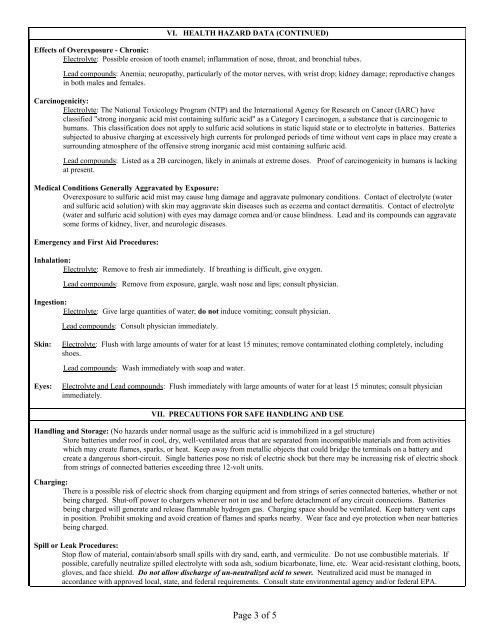MSDS FOR SONNENSCHEIN A600 DRYFIT BATTERY
MSDS FOR SONNENSCHEIN A600 DRYFIT BATTERY
MSDS FOR SONNENSCHEIN A600 DRYFIT BATTERY
Create successful ePaper yourself
Turn your PDF publications into a flip-book with our unique Google optimized e-Paper software.
VI. HEALTH HAZARD DATA (CONTINUED)<br />
Effects of Overexposure - Chronic:<br />
Electrolyte: Possible erosion of tooth enamel; inflammation of nose, throat, and bronchial tubes.<br />
Lead compounds: Anemia; neuropathy, particularly of the motor nerves, with wrist drop; kidney damage; reproductive changes<br />
in both males and females.<br />
Carcinogenicity:<br />
Electrolyte: The National Toxicology Program (NTP) and the International Agency for Research on Cancer (IARC) have<br />
classified "strong inorganic acid mist containing sulfuric acid" as a Category I carcinogen, a substance that is carcinogenic to<br />
humans. This classification does not apply to sulfuric acid solutions in static liquid state or to electrolyte in batteries. Batteries<br />
subjected to abusive charging at excessively high currents for prolonged periods of time without vent caps in place may create a<br />
surrounding atmosphere of the offensive strong inorganic acid mist containing sulfuric acid.<br />
Lead compounds: Listed as a 2B carcinogen, likely in animals at extreme doses. Proof of carcinogenicity in humans is lacking<br />
at present.<br />
Medical Conditions Generally Aggravated by Exposure:<br />
Overexposure to sulfuric acid mist may cause lung damage and aggravate pulmonary conditions. Contact of electrolyte (water<br />
and sulfuric acid solution) with skin may aggravate skin diseases such as eczema and contact dermatitis. Contact of electrolyte<br />
(water and sulfuric acid solution) with eyes may damage cornea and/or cause blindness. Lead and its compounds can aggravate<br />
some forms of kidney, liver, and neurologic diseases.<br />
Emergency and First Aid Procedures:<br />
Inhalation:<br />
Electrolyte: Remove to fresh air immediately. If breathing is difficult, give oxygen.<br />
Lead compounds: Remove from exposure, gargle, wash nose and lips; consult physician.<br />
Ingestion:<br />
Electrolyte: Give large quantities of water; do not induce vomiting; consult physician.<br />
Lead compounds: Consult physician immediately.<br />
Skin: Electrolyte: Flush with large amounts of water for at least 15 minutes; remove contaminated clothing completely, including<br />
shoes.<br />
Lead compounds: Wash immediately with soap and water.<br />
Eyes: Electrolyte and Lead compounds: Flush immediately with large amounts of water for at least 15 minutes; consult physician<br />
immediately.<br />
VII. PRECAUTIONS <strong>FOR</strong> SAFE HANDLING AND USE<br />
Handling and Storage: (No hazards under normal usage as the sulfuric acid is immobilized in a gel structure)<br />
Store batteries under roof in cool, dry, well-ventilated areas that are separated from incompatible materials and from activities<br />
which may create flames, sparks, or heat. Keep away from metallic objects that could bridge the terminals on a battery and<br />
create a dangerous short-circuit. Single batteries pose no risk of electric shock but there may be increasing risk of electric shock<br />
from strings of connected batteries exceeding three 12-volt units.<br />
Charging:<br />
There is a possible risk of electric shock from charging equipment and from strings of series connected batteries, whether or not<br />
being charged. Shut-off power to chargers whenever not in use and before detachment of any circuit connections. Batteries<br />
being charged will generate and release flammable hydrogen gas. Charging space should be ventilated. Keep battery vent caps<br />
in position. Prohibit smoking and avoid creation of flames and sparks nearby. Wear face and eye protection when near batteries<br />
being charged.<br />
Spill or Leak Procedures:<br />
Stop flow of material, contain/absorb small spills with dry sand, earth, and vermiculite. Do not use combustible materials. If<br />
possible, carefully neutralize spilled electrolyte with soda ash, sodium bicarbonate, lime, etc. Wear acid-resistant clothing, boots,<br />
gloves, and face shield. Do not allow discharge of un-neutralized acid to sewer. Neutralized acid must be managed in<br />
accordance with approved local, state, and federal requirements. Consult state environmental agency and/or federal EPA.<br />
Page 3 of 5

















